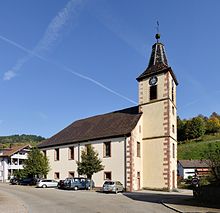Evangelical Church of Wies
The Evangelical Church of Wies in the community of Wies in the Lörrach district was built in the last third of the 18th century. It replaced a no longer existing church in the Demberg district, the capacity of which was insufficient for the number of parishioners. The organ from the 1780s is a listed building.
history
Church in Demberg
The first church in Demberg is mentioned for the first time in a letter of protection from Pope Innocent II. 1137 - it belonged to the Weitenau monastery until the time after the introduction of the Reformation (1556) . It was not until 1570 that the Demberger church appeared in the accounts of the Rötteln administration and was part of the Tegernaus church game . From visitation protocols from 1698 it can be concluded that the church was rebuilt after being destroyed in the Thirty Years War . The poor structural condition as well as the limited space due to the large geographical catchment area led to applications for a completely new construction in the more favorably located Wies at the end of the 18th century. After a rejection in 1764, the Margrave Friedrich was convinced to move the church in 1774. The community of Demberg wanted to let the church exist for other church purposes, but this was rejected in 1776. Instead, the building material of the Demberger church was used in the new church in Wies after it was demolished.
Today's church
With the decision in 1774 for the new church in Wies, state master builder Meerwein made plans for the new building in the same year. After two years of construction, the church was consecrated on September 12, 1777. Just one year later, the own parish of Wies was formed to whose parish the parts of Demberg, Fischenberg, Kühlenbronn and Stockmatt belonged; In 1779 Wambach was added.
An extensive interior renovation between 1963 and 1964 resulted in a more modern design of the altar area. The organ was moved from the choir to the western gallery above the main portal. The exterior renovation did not take place until 1976.
description
Church building
The church in Wies is centrally located in the town center. On the south side of the rectangular nave is a three-storey bell tower with an eight-sided, stepped pyramid roof , which has a tower ball and a weather vane on its top . Both buildings have corner cuboids that extend to the edge of the roof. The main entrance is on the west facade of the tower, above it is a rectangular window. On the second floor there are two smaller, rectangular windows. On the third floor there are rectangular sound arcades on each side and a clock face of the tower clock.
Interior and equipment
The main portal of the church is on the bell tower. When you enter the church, you find yourself in the tower hall, which has a plaque commemorating the victims of the Second World War . The console table underneath dates from 1775.
The hall church is drawn into the interior with a flat wooden ceiling. In the choir there is a modern altar with a pulpit. Above this, a pulpit protrudes from the wall in the middle of the altar area.
Bells
The four-part bell is composed as follows:
| No. | Chime | Casting year | Caster |
| 1 | as ′ | 1960 | Bachert , Karlsruhe |
| 2 | of'' | 1960 | Bachert, Karlsruhe |
| 3 | b ′ | 1926 | Bachert, Karlsruhe |
| 4th | f ′ ′ | 1922 | Bachert, Karlsruhe |
organ
In the years 1831/32 Josef Merklin built an organ for the church in Wies . Before that, attempts had already been made twice to procure an organ for the church, but this failed due to the financial possibilities. The instrument on the south pore , which is now a listed building, was built in 1787/88 by the Durlach organ builder Georg Marcus Stein for the Protestant St. Jakobskirche in Gernsbach . In 1855 the organ was sold to Wies. After repairs and minor alterations in 1866, 1891, 1902 and 1963, the last restoration to date was carried out by Orgelbau Link (Giengen / Brenz) in 1991/92 . With two manuals and 23 registers , the Wieser organ is Georg Marcus Stein's largest surviving instrument. With the exception of the prospect pipes and the bellows, the original instrument is one of the treasures among the organs of the region with its high historical inventory and its late Baroque Upper Rhine-French sound arrangement.
Your disposition is:
|
|
|
||||||||||||||||||||||||||||||||||||||||||||||||||||
- Coupling : II / I, I / P, II / P
literature
- Johannes Helm : Churches and chapels in the Markgräflerland , Müllheim / Baden 1989, ISBN 3-921709-16-4 , pp. 438–439.
- Bernd Sulzmann: Historical organs in Baden (1690–1890) , Munich / Zurich 1980, ISBN 3-7954-0421-5 , p. 114f.
Web links
Individual evidence
- ^ Helm: Churches and chapels in the Markgräflerland , p. 438 (01.2)
- ↑ A. Feßler: Churches and schools of the small meadow valley . In: Das Markgräflerland , 6th year, 1935, issue 4, p. 12
- ^ Helm: Churches and chapels in the Markgräflerland , p. 438 (02.1)
- ^ Helm: Churches and chapels in the Markgräflerland , p. 439 (02.2)
- ^ Helm: Churches and chapels in the Markgräflerland , p. 439; Sulzmann: Historical organs in Baden (1690–1890) , p. 114
Coordinates: 47 ° 44 '53.7 " N , 7 ° 46' 4.4" E




